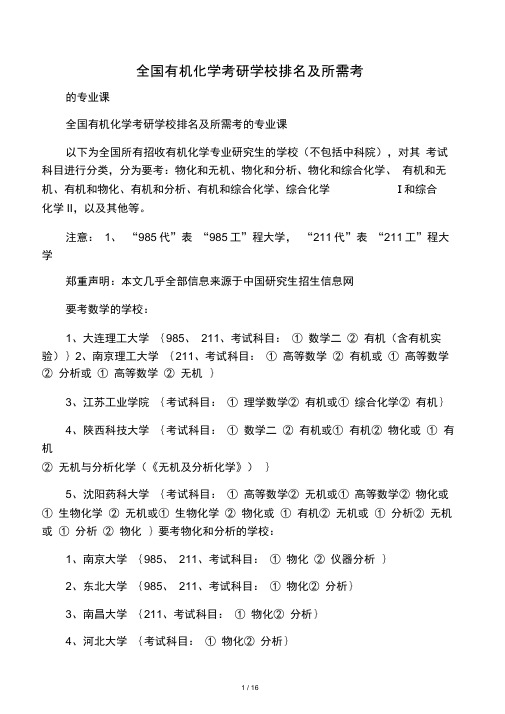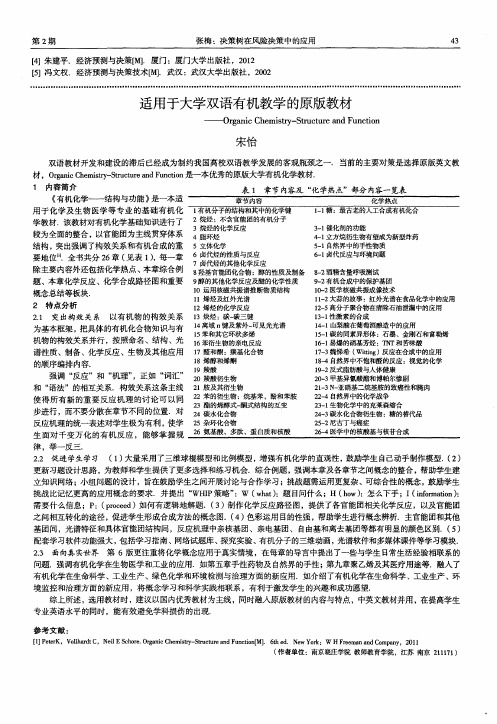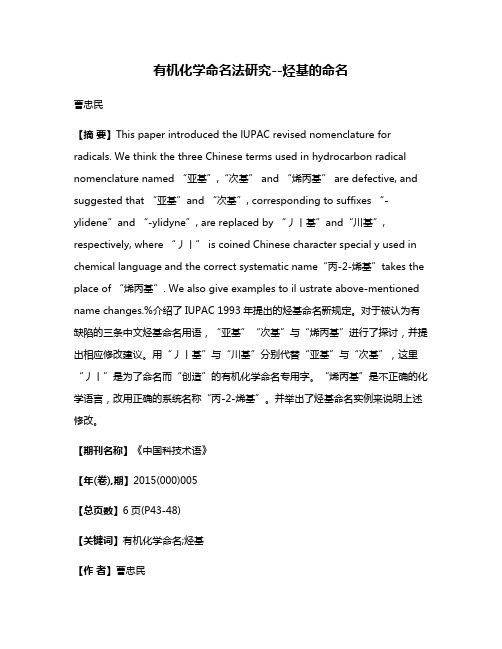大连理工有机化学{双语}
高等有机大作业:消除反应概述

大连理工大学高等有机化学课程论文消除反响概述Introduction of Elimination Reactions学院〔系〕:化学与环境生命学部专业:应用化学学生姓名:汪乐楠学号:202141348指导教师:评阅教师:完成日期:大连理工大学Dalian University of Technology摘要消除反响〔elimination reactions〕是有机化学中非常常见的一类反响,也是有机物合成中应用极广泛的一类反响,被用于不饱和有机分子的合成、有机物官能团与构型构象的转化等。
对各种类型消除反响的相关研究是有机合成领域长久以来的根底与热门课题。
本文试通过对消去反响的典型反响类型及其机理、影响反响的环境条件、反响的取向与竞争的简单综述,帮助读者深化全面地理解这一反响类型。
关键词:消除反响;概述;E1反响;E2反响;α-消除;γ-消除;立体化学;反响的竞争;本科生课程论文目录摘要 (III)引论 (1)1消除反响的分类 (2)E2反响 (2)E2反响机理 (2)E2反响的立体化学 (3)E1反响 (7)E1反响机理 (7)E1反响中的重排现象 (9)共轭碱单分子消除反响 (11)E1CB反响机理 (12)采取E1CB机理的条件 (12)β-羟基乙胺与α-羟基甲胺热消除反响 (13)楚加耶夫消除反响〔Chugaev Elimination〕 (13)α-消除反响 (15)γ-消除反响与其他消除反响类型 (16)2消除反响产物的区域选择性 (17)扎伊采夫规那么〔Saytzeff’s Rule〕 (17)霍夫曼规那么〔Hofmann’s Rule〕 (17)扎伊采夫取向与霍夫曼取向的竞争 (18)底物分子骨架与碱体积的影响 (18)α-官能团的影响 (18)β-官能团的影响 (20)潜在共轭体系 (20)小结:消除反响区域选择性的分析方法 (20)3消除与取代反响的竞争 (22)底物构造 (22)离去基团 (22)α-烷基与α-芳基 (22)β-烷基与β-芳基 (24)潜在共轭体系 (25)其他吸电子基团 (25)亲核试剂 (26)亲核试剂的碱性 (26)亲核试剂的体积〔空间位阻〕 (27)亲核试剂的浓度 (27)溶剂的极性 (28)反响温度 (30)小结:S N- E反响竞争的规律 (30)4总结 (33)参考文献 (34)致谢.............................................................................................. 错误!未定义书签。
大连理工大学有机化学——1

例二:命名 例二:
H C H3C O2N C H
COOCH3 CH2 H
*
OH
* C
CH2Cl
主要官能团为- 氯甲基 命名为酯羟基-5主要官能团为-COOCH3,命名为酯羟基 (2S,4R,5Z)-2-(氯甲基 命名为酯。 氯甲基)-3-硝基 。 硝基-2-羟基 硝基 庚烯酸甲酯(R / S); 2,4位C为手性碳,要标记构型 为手性碳, 标记构型( 位 为手性碳 ) 官能团顺序表,最低系列原则 顺序规则 官能团顺序表 最低系列原则,顺序规则;手性 最低系列原则 顺序规则; 5位C有双键,要标记构型(顺/反,E/Z)。 有双键, 位 有双键 要标记构型( 反 )。 双键,要标记构型(R , 反或 反或E/Z)。 碳、双键,要标记构型 / S,顺/反或 。
4.0 1 单
推测未知化合物可能的结构。 推测未知化合物可能的结构。
例 七
解:
从分子式分析, 从分子式分析,分子中有一个双键或一个 环结构,若有双键为 环结构,若有双键为C=C,C=O。 。 IR谱:在1700cm-1和3400cm-1有强吸收 谱 峰,则分子中有C=O,O-H键;可能是 则分子中有 , - 键 羧酸、羟基酮、羟基醛化合物, 羧酸、羟基酮、羟基醛化合物,不是环状 化合物。 化合物。
例 七
NMR谱:未知物有四种氢,都为单峰,互相不 谱 未知物有四种氢,都为单峰, 耦合;无相邻碳上的H;峰强度为: 耦合;无相邻碳上的 ;峰强度为:6:3:2:1, , 即6H,3H,2H,H共12个H。 共 个 。 分子中含有: -,-CH 分子中含有: -OH,CH3-,- 2-,H3C C ,
1 2 3 4 5 6
7 6 5 4 3 2
COOH
全国有机化学考研学校排名及所需考的专业课.

全国有机化学考研学校排名及所需考的专业课以下为全国所有招收有机化学专业研究生的学校(不包括中科院),对其考试科目进行分类,分为要考:物化和无机、物化和分析、物化和综合化学、有机和无机、有机和物化、有机和分析、有机和综合化学、综合化学Ⅰ和综合化学Ⅱ,以及其他等。
注意:1、“985”代表“985”工程大学,“211”代表“211”工程大学郑重声明:本文几乎全部信息来源于中国研究生招生信息网要考数学的学校:1、大连理工大学{985、211、考试科目:①数学二②有机(含有机实验)}2、南京理工大学{211、考试科目:①高等数学②有机或①高等数学②分析或①高等数学②无机}3、江苏工业学院{考试科目:①理学数学②有机或①综合化学②有机}4、陕西科技大学{考试科目:①数学二②有机或①有机②物化或①有机②无机与分析化学(《无机及分析化学》)}5、沈阳药科大学{考试科目:①高等数学②无机或①高等数学②物化或①生物化学②无机或①生物化学②物化或①有机②无机或①分析②无机或①分析②物化}要考物化和分析的学校:1、南京大学{985、211、考试科目:①物化②仪器分析}2、东北大学{985、211、考试科目:①物化②分析}3、南昌大学{211、考试科目:①物化②分析}4、河北大学{考试科目:①物化②分析}5、中南民族大学{考试科目:①物化②分析}6、沈阳药科大学{考试科目:①物化②分析}要考物化和无机的学校:1、厦门大学{985、211、考试科目:①物化②基础化学}2、南京大学{985、211、考试科目:①物化②大学化学}3、南京航空航天大学{211、考试科目:①物化②无机}4、南京师范大学{211、考试科目:①物化②无机}5、南昌大学{211、考试科目:①物化②无机}6、华南师范大学{211、考试科目:①物化②无机}7、中南民族大学{考试科目:①物化②无机}8、云南师范大学{考试科目:①物化②无机}注意:由于基础化学和大学化学和无机化学的内容几乎一样,故把基础化学和大学化学归为无机化学!!!要考物化和综合化学的学校:1、复旦大学{985、211、考试科目:①物化(含结构化学)②无机和分析}2、华中科技大学{985、211、考试科目:①物化②无机及分析}3、安徽大学{211、考试科目:①物化②综合化学}4、西北大学{211、考试科目:①物化②普通大学(无机和化学分析)}5、宁夏大学{211、考试科目:①物化②综合化学(有机、《无机化学与化学分析》)}6、河南大学{考试科目:①物化②无机和有机}7、浙江师范大学{考试科目:①物化②普通化学(有机、分析、仪器分析)}8、烟台大学{考试科目:①物化②化学综合(分析、无机、有机)}9、黑龙江大学{考试科目:①物化②综合化学(无机、有机、分析)}注意:《无机化学与化学分析》为参考书。
全国有机化学考研学校排名及所需考

全国有机化学考研学校排名及所需考的专业课全国有机化学考研学校排名及所需考的专业课以下为全国所有招收有机化学专业研究生的学校(不包括中科院),对其考试科目进行分类,分为要考:物化和无机、物化和分析、物化和综合化学、有机和无机、有机和物化、有机和分析、有机和综合化学、综合化学I和综合化学II,以及其他等。
注意:1、“985代”表“985工”程大学,“211代”表“211工”程大学郑重声明:本文几乎全部信息来源于中国研究生招生信息网要考数学的学校:1、大连理工大学{985、211、考试科目:① 数学二② 有机(含有机实验)}2、南京理工大学{211、考试科目:① 高等数学② 有机或① 高等数学② 分析或① 高等数学② 无机}3、江苏工业学院{考试科目:① 理学数学② 有机或① 综合化学② 有机}4、陕西科技大学{考试科目:① 数学二② 有机或① 有机② 物化或① 有机② 无机与分析化学(《无机及分析化学》)}5、沈阳药科大学{考试科目:① 高等数学② 无机或① 高等数学② 物化或① 生物化学② 无机或① 生物化学② 物化或① 有机② 无机或① 分析② 无机或① 分析② 物化}要考物化和分析的学校:1、南京大学{985、211、考试科目:① 物化② 仪器分析}2、东北大学{985、211、考试科目:① 物化② 分析}3、南昌大学{211、考试科目:① 物化② 分析}4、河北大学{考试科目:① 物化② 分析}5、中南民族大学{考试科目:① 物化② 分析}6、沈阳药科大学{考试科目:① 物化② 分析} 要考物化和无机的学校:1、厦门大学{985、211、考试科目:① 物化② 基础化学}2、南京大学{985、211、考试科目:① 物化② 大学化学}3、南京航空航天大学{211、考试科目:① 物化② 无机}4、南京师范大学{211、考试科目:① 物化② 无机}5、南昌大学{211、考试科目:① 物化② 无机}6、华南师范大学{211、考试科目:① 物化② 无机}7、中南民族大学{考试科目:① 物化② 无机}8、云南师范大学{考试科目:① 物化② 无机}注意:由于基础化学和大学化学和无机化学的内容几乎一样,故把基础化学和大学化学归为无机化学!!!要考物化和综合化学的学校:1、复旦大学{985、211、考试科目:① 物化(含结构化学)② 无机和分析}2、华中科技大学{985、211、考试科目:① 物化② 无机及分析}3、安徽大学{211、考试科目:① 物化② 综合化学}4、西北大学{211、考试科目:① 物化② 普通大学(无机和化学分析)}5、宁夏大学{211、考试科目:① 物化② 综合化学(有机、《无机化学与化学分析》)}6、河南大学{考试科目:① 物化② 无机和有机}7、浙江师范大学{考试科目:① 物化② 普通化学(有机、分析、仪器分析)}8、烟台大学{考试科目:① 物化② 化学综合(分析、无机、有机)}9、黑龙江大学{考试科目:① 物化② 综合化学(无机、有机、分析)}注意:《无机化学与化学分析》为参考书。
适用于大学双语有机教学的原版教材——Organic Chemistry-Structure and Function

宋怡
双语 教材开发和建设 的滞后 已经成为制 约我 国高校双语教学发展 的客观瓶颈之一. 当前 的主要对策是选择 原版英 文教 材 ,O r g a n i c c h e m i s t r y — s t mc t u r e a n d F u n c t i o n 是一本优 秀的原 版大学 有机化学教材. 1 内容简介 表 1 章节 内容及 t ・ 化学热点”部分 内 容 一览表 《 有机化学—— 结构与功能 》 是 一本适 节 内容 化 学热点 有机分子的结构和其中的化学键 l 一 1 糖 :最古老的人工合成有机化合 用 于化学及 生 物医学 等专 业 的基 础 有机 化 l 学教材.该教材对有机化学基础 知识 进行 了 2 烷烃 :不 舍官 能 团的有 机 分子 较为全面的整合 , 以官 能团为 主线贯 穿体 系 4 脂环 烃 结构 , 突出强调 了构效关 系和有 机合 成的重 5 立体 化学
需要什么信息 ;P : ( p r o c e e d ) 如 何有逻辑地解题.( 3 ) 制作化学 反应路径 图 , 提供 了各 官能 团相关化学反应 ,以及 官能团 之 间相互转化 的途径 , 促进学生形成合成方 法的概念 图. ( 4 ) 色彩运用 目的性强 , 帮助学生进行 概念 辨析 .主官能团和其他 基团间 ,光谱特征 和具体 官能团结 构间 ,反应机理 中亲核基 团、亲 电基 团、 自由基 和离去基 团等都有明显的颜色区别 .( 5 ) 配套学习软件功能强 大 , 包括学习指南 、 网络试题库 、 探究实验 、 有机分子 的三维动画 , 光谱软件和多媒体课件等学习模块. 2 . 3 面向真 实世界 第 6版更 注重将 化学概 念应用 于真实情境 , 在 每章 的导言中提出了一些与学生 日 常生活经验相联系的 问题.强调有机 化学在生 物医学和工业 的应 用.如第五章手 性药物及 自然界的手性 ; 第 九章 聚乙烯及其医疗用途等.融入了 有机化学在生命科学 、 工业生 产 、 绿色化学和环境检测与治理方面的新应用.如介绍 了有机化学在生命科学 、工业生产 、 环 境监控和治理方面的新应用 ,将概念学习和科学 实践 相联 系 ,有利 于激发学生的兴趣 和成 功愿望. 综 上所述 , 选 用教材 时 , 建议 以国 内优秀教材为主线 , 同时融入原版教材 的内容与特点 , 中英 文教材 并用 , 在提 高学生 专业英语水 平的同时 ,能有效避 免学科 损伤 的出现.
有机化学命名法研究--烃基的命名

有机化学命名法研究--烃基的命名曹忠民【摘要】This paper introduced the lUPAC revised nomenclature for radicals. We think the three Chinese terms used in hydrocarbon radical nomenclature named “亚基”,“次基” and “烯丙基” are defective, and suggested that “亚基”and “次基”, corresponding to suffixes “-ylidene”and “-ylidyne”, are replaced by “丿丨基”and“川基”, respectively, where “丿丨” is coined Chinese character special y used in chemical language and the correct systematic name“丙-2-烯基”takes the place of “烯丙基”. We also give examples to il ustrat e above-mentioned name changes.%介绍了IUPAC 1993年提出的烃基命名新规定。
对于被认为有缺陷的三条中文烃基命名用语,“亚基”“次基”与“烯丙基”进行了探讨,并提出相应修改建议。
用“丿丨基”与“川基”分别代替“亚基”与“次基”,这里“丿丨”是为了命名而“创造”的有机化学命名专用字。
“烯丙基”是不正确的化学语言,改用正确的系统名称“丙-2-烯基”。
并举出了烃基命名实例来说明上述修改。
【期刊名称】《中国科技术语》【年(卷),期】2015(000)005【总页数】6页(P43-48)【关键词】有机化学命名;烃基【作者】曹忠民【作者单位】大连理工大学化工学院,辽宁大连 116012【正文语种】中文【中图分类】N04;O62取代命名是通过取代基对母体氢化物的取代来描绘所命名分子的结构。
大连理工大学应用化学专业大二《高等有机化学》考试

大连理工大学应用化学专业大二《高等有机化学》考试1. 下列哪种性质不属于乙醇 [单选题] *A.易燃B.易挥发C.无色透明D.常温下是气态(正确答案)E.能与水互溶2. 乙醇与金属钠反映,会放出下列哪种气体() [单选题] *A.氧气B.氢气(正确答案)C.氮气D.甲烷E.氮气3. 下列哪种物质为无色透明有酒精味的液体,俗称“木醇”() [单选题] *A.乙醇B.丙三醇C.甲醇(正确答案)D.苯甲醇E.正丁醇4. ()的乙醇杀菌效果最好,在医药上用做消毒剂 [单选题] *A.50%B.60%C.75%(正确答案)D.80%E.90%5. 丙三醇的俗称为() [单选题] *A.酒精B.肌醇C.甘油(正确答案)D.木精E.鱼肝油6. 可以用来区别简单伯醇、仲醇和叔醇的试剂是() [单选题] *A.溴水B.卢卡斯试剂(正确答案)C.三氯化铁D.氢氧化铜E.硫酸7. 下列哪种性质是酚具有的化学性质() [单选题] *A.酸性B.碱性C.弱酸性(正确答案)D.弱碱性E.无腐蚀性8. 苯酚与三氯化铁的水溶液反应显() [单选题] *A.红色C.蓝色D.紫色(正确答案)E.白色9. 乙醛不易溶于下列哪种物质中() [单选题] *A.水B.乙醇C.煤油(正确答案)D.乙醚E.氯仿10. 昆虫叮咬人后,会向人体内注入一种(),使皮肤感到红肿疼痛, [单选题] *A.甲酸(正确答案)B.乙酸C.丙酸D.丁酸E.苯甲酸11. 下列物质中作为食醋主要成分的是() [单选题] *A.乙酸(正确答案)B.苯甲酸C.丁酸D.乙二酸E.甲酸12. 酸性最强的饱和二元羧酸是() [单选题] *B.乙酸C.苯甲酸D.草酸(正确答案)E.丁酸13. 羧酸的官能团是() [单选题] *A.羟基B.羧基(正确答案)C.羰基D.醛基E.苯甲基14. 碳原子的最外层有()个电子 [单选题] *A.3B.4(正确答案)C.5D.6E.715. 下列关于有机化合物特性的叙述不正确的是() [单选题] *A.多数可燃烧B.多数稳定性差C.一般易溶于水(正确答案)D.多数反应速率慢E.包含碳、氢元素16. 芳香族化合物属于() [单选题] *A.开链化合物B.杂环化合物C.碳环化合物(正确答案)D.脂环族化合物E.单质17. 下列说法正确的是() [单选题] *A.含碳的化合物一定是有机化合物B.有机化合物中一定含有碳元素(正确答案)C.H2CO3可以归类为有机化合物D.在有机化合物中,碳的化合价可以是二价,也可以是四价E.有机化合物一定可以燃烧18. 有机化合物种类繁多的主要原因() [单选题] *A.自然界存在大量的有机化合物B.有机化合物有多重官能团C.有机化合物含有多种元素D.有机化合物普遍存在同分异构体(正确答案)E.有机化合物有多种形态19. 下列化合物中存在羧基的是() [单选题] *A.CH3CH3B.CH3CH2OHC.CH3OCH 3D.CH3COOH(正确答案)E.CH420. 下列属于饱和链烃的是() [单选题] *A.烯烃B.炔烃C.二烯烃D.烷烃(正确答案)E.芳香烃21. 下列物质中,不属于戊烷性质的是() [单选题] *A.无色透明B.易挥发C.芳香气味D.常温下为液态E.常温下为气态(正确答案)22. 碳原子的类型,不包括下面哪一类( [单选题] *A.伯碳原子B.仲碳原子C.叔碳原子D.季碳原子E.庚碳原子(正确答案)23. 烷烃的主要性质不包括下面哪一项( [单选题] *A.由碳氢元素组成B.以单键连接C.大部分可燃烧D.常温下全部都是气态(正确答案)E.不存在双键24. 下列物质中,在一定条件下能与甲烷发生取代反应的是() [单选题] *A.氯气(正确答案)B.氧气C.氢气D.氯化氢E.氮气25. 下列物质中,不属于烷烃同系物的是() [单选题] *A.CH4B.CH3CH3C.C4H8(正确答案)D.C3H8E.C6H1426. 下列物质中,不属于烯烃的是() [单选题] *A. C4H8B. C5H10C. C4H10(正确答案)D. C7H14E. C6H1227. 乙烯的分子结构描述正确的是() [单选题] *A.正四面体B.平面型(正确答案)C.平面正六边形D.直线型E.三角形28. 甲烷的分子结构描述正确的是() [单选题] *A.正四面体(正确答案)B.平面型C.平面正六边形D.直线型E.三角形29. 苯酚与溴水作用生成的沉淀是() [单选题] *A.黑色B.白色(正确答案)C.紫色D.绿色E.蓝色30. 下列属于甲酚异构体类型的是() [单选题] *A.邻甲酚(正确答案)B.三溴苯酚C.乙酚D.苯酚E.对苯二酚31. “来苏儿”常用于医疗器械和环境消毒,其主要成分是() [单选题] *A.已烷B.甲酚(正确答案)C.苯酚D.乙烯E.乙醇32. 醇、酚、醚都是烃的() [单选题] *B.同分异构体C.同系物D.含氧衍生物(正确答案)E.同素异形体33. 在常温下不是气体的是() [单选题] *A.甲醚B.甲乙醚C.乙醚(正确答案)D.甲烷E.乙烯34. 福尔马林是指() [单选题] *A.40%的甲醛水溶液(正确答案)B.50%的甲醛水溶液C.60%的甲醛水溶液D.70%的甲醛水溶液E.90%的甲醛水溶液35. 下列试剂中最适合用来鉴别CH3CH=CH2和CH3C=CH的是() [单选题] *A.Cl2B.酸性高锰酸钾溶液C.溴水D.硝酸银的氨水溶液(正确答案)E.稀盐酸36. 下列物质中不属于脂环烃的是() [单选题] *B.环丁烯C.环已炔D.苯(正确答案)E.环戊烷37. 苯分子中碳原子和氢原子的比例为() [单选题] *A.4:1B.3:1C.2:1D.1: 1(正确答案)E.1:238. 烷烃的分子组成可以用通式( )表示 [单选题] *H2nH2n+ 1H2n-2H2n+ 2(正确答案)H2n-l39. 下列哪种官能团是醇的官能团() [单选题] *A.羟基(正确答案)B.醛基C.羰基D.羧基E.羰基40. 根据分子中羟基的数目分类,下列哪一种不属于多元醇的是() [单选题] *A.乙醇(正确答案)B.丙三醇C.2,2,3丁三醇D.2,2,3,3已四醇E.2.2.4已三醇41. 下列物质中,不属于烷烃同系物的是() [单选题] *A.CH4B.CH3CH3C.C4H8(正确答案)D.C3H8E.C6H1442. 下列物质中,不属于烯烃的是() [单选题] *A. C4H8B. C5H10C. C4H10(正确答案)D. C7H14E. C6H1243. 下列试剂中最适合用来鉴别CH3CH=CH2和CH3C=CH的是() [单选题] *A.Cl2B.酸性高锰酸钾溶液C.溴水D.硝酸银的氨水溶液(正确答案)E.稀盐酸44. 下列物质中不属于脂环烃的是() [单选题] *B.环丁烯C.环已炔D.苯(正确答案)E.环戊烷45. 苯及其同系物的组成通式为() [单选题] *H2n-6(n≥6)(正确答案)B.C2nH2n-6(n≥6)C3nH2n-6(n≥6)D.C4nH2n-6(n≥6)E.C5nH2n-6(n≥6)46. 下列哪种官能团是醇的官能团() [单选题] *A.羟基(正确答案)B.醛基C.羰基D.羧基E.羰基47. 根据分子中羟基的数目分类,下列哪一种不属于多元醇的是() [单选题] *A.乙醇(正确答案)B.丙三醇C.2,2,3丁三醇D.2,2,3,3已四醇E.2.2.4已三醇48. 下列哪种性质不属于乙醇() [单选题] *B.易挥发C.无色透明D.常温下是气态(正确答案)E.能与水互溶49. 乙醇与金属钠反映,会放出下列哪种气体( [单选题] *A.氧气B.氢气(正确答案)C.氮气D.甲烷E.氮气50. 下列哪种物质为无色透明有酒精味的液体,俗称“木醇”() [单选题] *A.乙醇B.丙三醇C.甲醇(正确答案)D.苯甲醇E.正丁醇51. 丙三醇的俗称为() [单选题] *A.酒精B.肌醇C.甘油(正确答案)D.木精E.鱼肝油52. 可以用来区别简单伯醇、仲醇和叔醇的试剂是() [单选题] *B.卢卡斯试剂(正确答案)C.三氯化铁D.氢氧化铜E.硫酸53. 下列哪种性质是酚具有的化学性质() [单选题] *A.酸性B.碱性C.弱酸性(正确答案)D.弱碱性E.无腐蚀性54. 苯酚与三氯化铁的水溶液反应显() [单选题] *A.红色B.黑色C.蓝色D.紫色(正确答案)E.白色55. 苯酚与溴水作用生成的沉淀是() [单选题] *A.黑色B.白色(正确答案)C.紫色D.绿色E.蓝色56. 下列属于甲酚异构体类型的是() [单选题] *A.邻甲酚(正确答案)B.三溴苯酚C.乙酚D.苯酚E.对苯二酚57. “来苏儿”常用于医疗器械和环境消毒,其主要成分是() [单选题] *A.已烷B.甲酚(正确答案)C.苯酚D.乙烯E.乙醇58. 醇、酚、醚都是烃的() [单选题] *A.同位素B.同分异构体C.同系物D.含氧衍生物(正确答案)E.同素异形体59. 在常温下不是气体的是() [单选题] *A.甲醚B.甲乙醚C.乙醚(正确答案)D.苯乙醚E.乙烷60. 乙醛不易溶于下列哪种物质中() [单选题] *B.乙醇C.煤油(正确答案)D.乙醚E.氯仿61. 昆虫叮咬人后,会向人体内注入一种()使皮肤感到红肿疼痛 [单选题] *A.甲酸(正确答案)B.乙酸C.丙酸D.丁酸E.苯甲酸62. 下列物质中作为食醋主要成分的是() [单选题] *A.乙酸(正确答案)B.苯甲酸C.丁酸D.乙二酸E.甲酸63. 酸性最强的饱和二元羧酸是() [单选题] *A.甲酸B.乙酸C.苯甲酸D.草酸(正确答案)E.丁酸64. 羧酸的官能团是() [单选题] *B.羧基(正确答案)C.羰基D.醛基E.苯甲基65. 烷烃分子中碳原子的空间几何形状是() [单选题] *A.四面体形(正确答案)B.平行四边形C.线形D.六面体形66. 异戊烷和新戊烷互为同分异构体的原因是() [单选题] *A.具有相似的化学性质B.具有相同的物理性质C.具有相同的结构D.分子式相同,但碳链的排列方式不同(正确答案)67. 石油醚是实验室中常用的有机试剂,它的成分是( ) [单选题] *A.一定沸程的烷烃混合物(正确答案)B.一定沸程的芳烃混合物C.醚类混合物D.烷烃和醚的混合物68. 68甲基环丙烷与5%KMn₄。
有机化学第三版大连理工课后答案详解

有机化学第三版大连理工课后答案详解1、下列方法中哪一个不是按照色谱法的操作形式不同而进行分类的()[单选题] * A离子交换色谱(正确答案)B薄层吸附色谱C纸色谱D吸附柱色谱2、下列化合物中,酸性最强的是()[单选题] *A芦荟大黄素B大黄酚C大黄素甲醚D大黄酸(正确答案)3、E连续回流提取法(正确答案)用乙醇作溶剂提取时,下列说法正确的是()*A对植物细胞壁穿透力强(正确答案)B溶解范围广,提取较全面(正确答案)C提取液中蛋白质、多糖等水溶性杂质少(正确答案)D有防腐作用,提取液不易发霉变质(正确答案)4、淀粉含量多的药材提取时不宜用()[单选题] * A浸渍法B渗漉法C煎煮法(正确答案)D回流提取法5、一般情况下,为无色的化合物是()[单选题] * A黄酮B花色素C二氢黄酮(正确答案)D查耳酮6、挥发油可析出结晶的温度是()[单选题] *A0~-20℃(正确答案)B0~10℃C0~20℃D0~15℃7、牛蒡子属于()[单选题] *A香豆素类C苯丙酸类D8、在溶剂沉淀法中,主要是在溶液中加入另一种溶剂一改变混合溶剂的什么实现的()[单选题] *ApH值B溶解度C极性(正确答案)D体积9、可沉淀具有羧基或邻二酚羟基成分的沉淀法是()[单选题] *A溶剂沉淀法B醋酸铅沉淀法(正确答案)C酸碱沉淀法D水提醇沉法10、属于二萜的化合物是()[单选题] *A龙脑B月桂烯C薄荷醇11、用有机溶剂加热提取中药成分时,宜采用(多选)()*A浸渍法B渗漉法C煎煮法D回流提取法(正确答案)12、中药补骨脂中的补骨脂内脂具有()[单选题] *A抗菌作用B光敏作用(正确答案)C解痉利胆作用D抗维生素样作用13、乙醇不能提取出的成分类型是()[单选题] *A生物碱B苷C多糖D鞣质(正确答案)14、木脂素是苯丙素衍生聚合而成的天然化合物,多为()[单选题] *A二聚体(正确答案)B三聚体C四聚体D五聚体15、连续回流提取法在实验室用的装置为()[单选题] * A氏提取器(正确答案)B回流装置C蒸馏装置D分液漏斗16、可与异羟肟酸铁反应生成紫红色的是()[单选题] * A羟基蒽醌类B查耳酮类C香豆素类(正确答案)D二氢黄酮类17、中药紫草中的主要有效成分属于()[单选题] *A苯醌类B萘醌类(正确答案)C蒽醌类D菲醌类18、薄层吸附色谱中的Rf的大小说明了吸附程度的大小,吸附力越大,则Rf()[单选题] *A越大B越小(正确答案)C越接近1D越接近019、从香豆素类的结构看,香豆素是一种()[单选题] *A内酯(正确答案)B羧酸C酰胺D糖20、以橙皮苷为指标成分进行定性鉴别的中药是()[单选题] *A葛根B黄芩C槐花D陈皮(正确答案)21、关于肿节风,说法正确的有(多选)()*A别名:接骨金粟兰、九节茶等(正确答案)B功能主治抗菌消炎凉血清热解毒(正确答案)C肿节风为白色针晶(正确答案)D不易溶于甲醇,乙醇22、组成缩合鞣质的基本单元是()[单选题] *A黄烷-3-醇(正确答案)B酚羟基C环戊烷D哌啶环23、E连续回流提取法(正确答案)下列方法中能始终保持良好浓度差的是()* A浸渍法B渗漉法(正确答案)C煎煮法D回流提取法24、南五味子具有的主要化学成分是()[单选题] *A色原酮B胆汁酸C多糖D木脂素(正确答案)25、临床上应用的黄连素主要含有()[单选题] *A奎宁B小檗碱(正确答案)C粉防己碱D苦参碱26、阿托品的结构类型是()[单选题] *A喹啉类B异喹啉类C莨菪烷类(正确答案)D苄基异喹啉类27、香豆素衍生物最常见的羟基取代位置是()[单选题] * AC7位(正确答案)BC5位CC3位DC6位28、香豆素及其苷发生异羟肟酸铁反应的条件为()[单选题] *A在酸性条件下B在碱性条件下C先碱后酸(正确答案)D在中性条件下29、下列含香豆素类成分的中药是(多选)()*A秦皮(正确答案)B甘草C补骨脂(正确答案)D五味子30、所有游离香豆素均可溶于热的氢氧化钠水溶液,是由于其结构中存在()[单选题] * A异戊烯基B酮基C内酯环(正确答案)D酚羟基对位活泼氢。
- 1、下载文档前请自行甄别文档内容的完整性,平台不提供额外的编辑、内容补充、找答案等附加服务。
- 2、"仅部分预览"的文档,不可在线预览部分如存在完整性等问题,可反馈申请退款(可完整预览的文档不适用该条件!)。
- 3、如文档侵犯您的权益,请联系客服反馈,我们会尽快为您处理(人工客服工作时间:9:00-18:30)。
编著与制作: 南华大学 邓健
19
The position of the equilibrium between gem diols and aldehydes / ketones depends on the structure of the carbonyl compound.
+
H OH H NH-NH2 XMg R''
编著与制作: 南华大学 邓健
1. React with HCN (hydrocyanic acid)
Aldehydes and ketones react with HCN to produce cyanohydrins (氰醇). The nucleophilic cyanide ion adds to the electrophilic carbonyl carbon.
Nucleophilic oxygen reacts - with acids and electrophiles
O ——C———C H
(2) Activity of -hydrogen
+ (1) Electrophilic carbon reacts with bases and nucleophiles
OH R C H( CH3 ) CN 氰醇
This reaction is only suitable to the aldehydes, alkyl methylketones, and cycloketones (C≤8) (醛、脂肪族甲基酮、8C以下环酮适用)
H
activity
H
C=O
> H C=O > (
CHO
CHO
Cyclohexanecarbaldehyde 2-Naphthalenecarbaldehyde 环己基甲醛 2-萘甲醛 (3) Aromatic aldehydes are also named as derivatives of the parent benzaldehyde. benzaldehyde
+
O
C
H H ( :Nu H H H
-
: CN : SO3Na ) : OR H+ : OH + (E ) : NH-G
O-H C
Nu
XMg: R Cyanide ion(CN-), bisulphite anion, alcohols, H2O, ammonia and carbon anions (R3C-) are several of many possibilities.
CHO
O C- CH 3
2
编著与制作: 南华大学 邓健
Ⅱ. Nomenclature
1. Aldehydes
(1) The IUPAC names for aldehydes are derived from the parent hydrocarbon by identifying the longest chain containing the aldehyde group (-CHO) and replacing the ‘-e’ ending with ‘-al’.
O CH3
3-Methylcyclohexanone
(3) Ketones in which the carbonyl group is attached directly to a benzene ring are named as phenyl derivatives of the corresponding aliphatic carbonyl compound.
CH3 O O CH3CH CHC H 4 3 2 1 2-Butenal
编著与制作: 南华大学 邓健 3
CH3CHCH2CH2C H 5 4 3 2 1 4-Methylpentanal
(2) For more complex aldehydes in which the –CHO group is attached to a ring, the suffix –carbaldehyde is used.
第 9 章 醛 和 酮
Chapter 9 Aldehydes and Ketones
Sec 1
Classification & Nomenclature
Sec 2 Structure Sec 3 Properties
编著与制作: 南华大学 邓健 1
Sec 1 Classification & Nomenclature
OH O + H or OH A gem R C R'(H) O H R C R'(H) + 2 diol OH
The reaction is reversible, and a gem diol can eliminate water to regenerate a ketone or aldehyde.
O-CH3 C—H O-CH3 + H2O
The reaction of ketone with alcohol is slower than aldehyde’s, but cyclic acetal is easily formed.
CH3
dry HCl CH3 O HO An cyclic C O+ C acetal CH3 HO CH3 O Ethylene glycol Acetone ethylene ketal
(H)
(3) The aldehyde H will be lost easily
编著与制作: 南华大学 邓健
8
Ⅰ. Nucleophilic Addition (亲核加成)
The most common reaction of aldehydes and ketones is the nucleophilic addition reaction, in which a nucleophile (:Nu or :Nu-) adds to the electrophilic carbon of the carbonyl group.
O CH3CH2CH2CCH3 O CH2=CHCCH2CH2CH3
5
4
2 1
1
3
6
2-Pentanone 2-戊酮
O CH3 C O CH2 C CH3
1-Hexen-3-one 1-己烯-3-酮
2,4-Pentanedione 2,4-戊二酮
5
编著与制作: 南华大学 邓健
(2) Cyclic ketones are named with the carbonyl group occupying the 1-position in the ring.
O R—C—H
+ 2 HO—R’
dry HCl
OR' H R C
+ H2O
OR'
1,1-Dialkoxyalkane (Acetal, 缩醛)
编著与制作: 南华大学 邓健 15
O CH3C-H +EtOH
Acetaldehyde
OH
dry HCl
CH3-C-OEt
EtOH
OEt CH3-C-OEt
CHO
CHO
1 2 3
Benzenecarbaldehyde Benzaldehyde 苯甲醛
4
4-Bromobenzaldehyde (p-Bromobenzaldehyde)
Br
2. Ketones
(1) In the IUPAC system, ketones are named by identifying the longest chain containing the carbonyl group and replacing the ‘ –e ’ with ‘–one.
编著与制作: 南华大学 邓健
R
)
>
CH3 C=O R
13
2. React with sodium bisulphite (NaHSO3)
O R —C — H
+
OH :S—O- Na+ O
ONa R — C—H SO3H
OH R—C—H SO3Na
α-Hydroxysodium sulfonate α-羟基磺酸钠
H HO-CH2-CH2-CH2-C=O
OH
H 89%
H HO-CH2-CH2-CH2-CH2-C=O
OH
H 94%
编著与制作: 南华大学 邓健
18
4. React with H2O: Hydration
Aldehydes and ketones undergo nucleophilic addition with water to yield 1,1-diols, or geminal (gem) diols.
H Acetaldehyde ethyl hemiacetal
H HOH Acetaldehyde diethyl acetal
O C—H + CH3OH NO2
H2SO4
(trace) NO2 76~65% 3-Nitrobenzaldehyde dimethyl acetal
3-硝基苯甲醛二甲基缩醛
编著与制作: 南华大学 邓健 9
Mechanism of Nucleophilic Addition
Nu:
(—)
slow
H+
Nu
H
Nu
fast
Step 1 is the slowest, so this reaction is called as nucleophilic addition.
